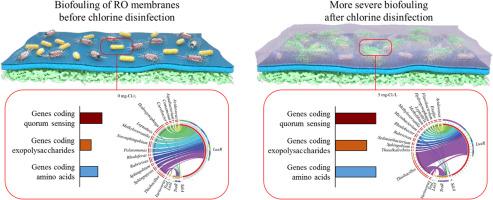Journal of Hazardous Materials ( IF 12.2 ) Pub Date : 2020-11-18 , DOI: 10.1016/j.jhazmat.2020.124602 Yun-Hong Wang , Yin-Hu Wu , Li-Wei Luo , Qi Wang , Xin Tong , Yuan Bai , Xin-Ye Ni , Hao-Bin Wang , Gen-Qiang Chen , Ikuno Nozomu , Zhuo Chen , Hong-Ying Hu

|
Chlorine disinfection is a common technology to control biofouling in the pretreatment of the reverse osmosis (RO) system for wastewater reclamation. However, chlorine disinfection could even aggravate the RO membrane biofouling because of the changes of microbial community structure. In this study, the mechanism of biofilm formation and EPS secretion after chlorine disinfection was investigated by analyzing the genes coding quorum sensing, exopolysaccharide biosynthesis, and amino acid biosynthesis. After 1, 5, and 15 mg-Cl2/L chlorine disinfection, the relative abundances of the functional genes all increased significantly. Compared with the control group, chlorine-resistant bacteria (Acidovorax, Arenimonas, and Pseudomonas) also harbored higher relative abundances of these functional genes. The high relative abundances of these genes might provide the bacterial community after chlorine disinfection with high potential of biofilm formation and EPS secretion and then cause severe RO membrane biofouling. In the sample with 5 mg-Cl2/L chlorine disinfection, the correlation coefficients (r) between each two of the three kinds of functional genes were more than 0.9 and much stronger than that in the control group. These results indicated that the bacterial community selected by chlorine disinfection could build more stable biofilm to resist chlorine but also could cause more severe RO membrane biofouling.
中文翻译:

氯消毒后与反渗透膜生物污染加剧相关的关键功能基因的元基因组学分析
氯消毒是在废水回收利用的反渗透(RO)系统预处理中控制生物结垢的常用技术。然而,由于微生物群落结构的变化,氯消毒甚至会加重反渗透膜的生物污染。在这项研究中,通过分析编码群体感应,胞外多糖生物合成和氨基酸生物合成的基因,研究了氯消毒后生物膜形成和EPS分泌的机制。在1、5和15 mg-Cl 2 / L氯消毒后,功能基因的相对丰度都显着增加。与对照组相比,耐氯细菌(嗜酸菌,槟榔和假单胞菌))也包含这些功能性基因的相对较高的丰度。这些基因的较高相对丰度可能会为氯消毒后的细菌群落提供高生物膜形成和EPS分泌的潜力,然后导致严重的RO膜生物污染。在用5 mg-Cl 2 / L氯消毒的样品中,三种功能基因中的每两种之间的相关系数(r)均大于0.9,并且比对照组要强得多。这些结果表明,通过氯消毒选择的细菌群落可以建立更稳定的生物膜来抵抗氯,但也可能导致更严重的反渗透膜生物污染。











































 京公网安备 11010802027423号
京公网安备 11010802027423号